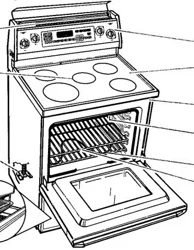Loading ...
Loading ...
Loading ...

' . sing and Caring for Your Cooktop
To use the small element for smaller
pans:
Push in and turn control knob to the left
(counterclockwise) to the desired setting in
the area marked "SINGLE ".
Using the ceramic glass cooktop
Cooking on the ceramic glass cooktop is
almost the same as cooking on coil surface
units. There are, however, a few differences:
• The cooking surface area wilt glow red
when the element is turned on. You will see
the element cycling on and off - even on
the HI setting - to help the area stay at the
temperature setting you choose.
• Make sure the bottoms of pots and pans
are clean and dry before cooking. Food
and water particles left on the bottoms can
leave deposits on the cooktop when it is
heated.
• Wiping off the cooktop before and after
each use will help keep the surface free
from stains and give you the most even
heating. See the "Cleaning tips" section.
• Do not cook foods directly on the cooktop.
• Lift pots and pans onto and off of the
cooktop. Sliding pots and pans on the
cooktop could leave marks that are difficult
to remove or could leave permanent marks.
• Do not cook popcorn that comes in
prepackaged aluminum containers on the
cooktop. The container could leave
aluminum marks on the cooktop that
cannot be removed completely.
• Do not use the cooktop as a cutting board.
• Do not allow anything that could melt,
such as plastic or aluminum foil, to come
in contact with the cooktop while it is hot.
• Dropping a heavy or hard object on the
cooktop could crack it. Be careful when
using heavy skillets and large pots. Do
not store jars or cans above the cooktop.
• Sugary spills and soils can cause pitting.
See the "Cleaning tips" section.
Cookware tips
• Select a pan that is about the same size
as the surface cooking area. Cookware
should not extend more than 1 inch
(2.5 cm) outside the area.
• For best results and greater energy
efficiency, use only flat-bottomed
cookware that makes good contact with
the surface cooking area. Cookware with
rounded, warped, ribbed (such as some
porcelain enamelware), or dented bottoms
could cause uneven heating and poor
cooking results.
• Cookware designed with slightly indented
bottoms or small expansion channels can
be used.
• Cookware with non-stick finish has
heating characteristics of the base material.
• Check for rough spots on the bottom of
metal or glass cookware which will scratch
the ceramic glass surface.
• Use flat bottom cookware for best heat
conduction from the surface cooking area
to the cookware. Determine flatness with
the ruler test. Place the edge of a ruler
across the bottom of the cookware. Hold it
up to the light. No light should be visible
under the ruler. Rotate the ruler in all
directions and look for any light.
• Do not leave empty cookware, or
cookware that has boiled dry, on a hot
surface cooking area. The cookware
could overheat, causing damage to the
cookware or the surface cooking area.
11
Loading ...
Loading ...
Loading ...
